AMX SDX-510M-DX Handleiding
AMX
Niet gecategoriseerd
SDX-510M-DX
Bekijk gratis de handleiding van AMX SDX-510M-DX (2 pagina’s), behorend tot de categorie Niet gecategoriseerd. Deze gids werd als nuttig beoordeeld door 83 mensen en kreeg gemiddeld 4.1 sterren uit 42 reviews. Heb je een vraag over AMX SDX-510M-DX of wil je andere gebruikers van dit product iets vragen? Stel een vraag
Pagina 1/2

QUICK START GUIDE
SDX-510M-DX Solecis® Digital Switcher
Overview
This guide pertains to the SDX-510M-DX 5x1 Multi-Format Digital Switcher with
DXLink Output (FG1010-315). The purpose of this document is to illustrate how the
device is to be installed and set up in its simplest configuration by a trained
technician.
Additional Documentation
Additional documentation for this device is available at www.amx.com. Refer to the
Solecis SDX Digital Switchers Instruction Manual for additional details on installing,
upgrading, and wiring the SDX-510M-DX.
You can also access this Quick Start Guide online by using your mobile device to scan
the QR code located on the bottom of the switcher.
What’s in the Box?
The following items are included with the SDX-510M-DX:
• (2) 5-pin Phoenix connectors
• (1) 4-pin Phoenix connector
• (1) 3-pin Phoenix connector
• (4) rubber feet
• (1) universal power cord
Power
Active power requirements:
• Voltage, AC (typical): 110-240VAC, 50-60 Hz
• Power consumption (max): 110V, 60Hz = 59W; 240V 50Hz = 68W
Environmental Requirements
The environmental requirements for the SDX-510M-DX are as follows:
•Operating Temperature: 32° F (0° C) to 104° F (40° C)
•Storage Temperature: -4° F (-20° C) to 158° F (70° C)
•Operating Humidity: 5% to 85% RH (non-condensing)
•Storage Humidity: 0% to 90% RH (non-condensing)
Conf iguration
Perform the following to prepare the switcher for network communication:
Setting the Configuration DIP Switches
Use the Configuration DIP switch to enable/disable the LAN ports and set network
connectivity. DIP switch settings are read on reboot. Any changes to the DIP switch
settings are not acted upon until after you reboot the device.
Enabling the LAN 10/100 Ports
The LAN 10/100 ports on the switchers are disabled by default. You can enable the
ports by setting #1 DIP switch to ON (see FIG. 1).
Enabling Network Connectivity
Network connectivity on the switchers is disabled by default. You can enable network
connectivity by setting #3 DIP switch to ON (see FIG. 1).
FIG. 1 CONFIGURATION DIP SWITCH
Installation
Before connecting the switcher to its peripheral devices and powering the device, be
sure to mount the device using one of the methods detailed below. You can also
pole-mount the switcher using the V Style Single Module Pole Mounting Kit (FG1010-
723). The switchers also include rubber feet that you can apply to the bottom of the
device for table-top mounting.
Surface Mounting
The Solecis Digital Switchers can be mounted using V Style Surface Mounting
Brackets (FG1010-722). The Surface Mount Brackets are designed for mounting a
single module (to a wall, on or under a desk, etc.) The brackets may be attached to
mount the top or the bottom flush with the mounting surface.
Rack Mounting
You can mount the switcher on a rack shelf by using an NMX-VRK V-Style Rack Shelf
(FG3201-60). In addition to the switcher, you can also use wire ties to mount the
switcher’s power supply on the rack shelf.
1. Invert the switcher and the rack shelf for ease of installation.
2. Attach the rack shelf to the bottom of the switcher using the #4-40 3/16 inch
undercut flat head screws (provided). Insert the screws through the underside
of the rack shelf and into the holes on the bottom of the switcher. Note that
only two screws are required.
3. Install the rack shelf in a standard EIA 19 in. (48.26 cm) rack and secure with
rack-mounting screws.
4. (This step is optional.) Attach fill plates using the #4-40 3/16 inch undercut
flat head screws (provided). Be sure to use the screw holes closest to the front
of the tray.
Getting Connected
The following sections describe how to connect your switcher to your network,
audio/video sources, and accessories.
Connecting the Switcher to a Video Input
The two GROUP INPUTS areas on the rear panel each feature an HDMI port, a 15-pin
VGA port, a 1/8" mini-Stereo jack, and a 5-pin 3.5mm Dual External Button/LED
Control connector. The HDMI input supports a digital audio/video source. The VGA
input port supports analog video. Use the 1/8" mini-Stereo jack for analog audio.
Though these two sets of input ports support separate digital and analog video
sources, you can only select one input at a time to be sourced to the output ports.
Use the first external button LED control connector to cycle through the inputs
within a particular group. HDMI INPUT 1 is always the first input on both groups.
Group 1 contains inputs 1, 2, and 3. Group 2 contains inputs 1, 4, and 5. You can
route the audio/video from one input within a group at a time. You can cycle through
the inputs in each group by clicking a single button module connected to the
External button connector located next to HDMI INPUT 1 on the rear panel of the
device.
Connecting the Switcher to a Video Output
The switchers can transmit a signal simultaneously to both DXLink and HDMI
outputs.
• The switcher uses standard HDMI cabling to connect to the HDMI inputs and
outputs. Use an HDMI cable to connect the HDMI OUT port on the front panel
of the switcher to the display device.
• The switcher uses category cabling to connect to the DXLink output. See the
Important Twisted Pair Cabling Requirements and Recommendations section for
information about cable requirements for the DXLink port. Use category
cabling to connect the DXLINK port on the front panel of the switcher to the
DXLink input port on a DXLink receiver, Enova DVX switcher, or Enova DGX
switcher.
Applying Power
Once you have mounted the switcher, set the DIP switches, and connected the
appropriate input and output devices to the ports on the switcher, apply power by
connecting the universal power cord supplied with the switcher.
Video Switching
Auto Switching mode is the default switching mode. With Auto Switching mode, the
switcher responds to the most recently added video input by switching the new input
to display on the HDMI and DXLink output. If the currently selected video source is
removed, the switcher switches to the PC-IN input. If the PC-IN input is removed, the
switcher remains on the PC-IN input.
You can disable Auto Switching mode by using the VIDIN_AUTO_SELECT NetLinx
command. See the Solecis SDX Digital Switchers Instruction Manual for more
information on this command.
To switch between video inputs that have already been established, you can perform
one of the following:
• Use the Select button on the front of the panel to toggle through the video
inputs.
• Use a connected external button (not included) with the External Button/LED
Control connector (#1) located on the rear panel of the switcher (to the left of
HDMI IN 1). Each external button press provides the same functionality as the
Select button on the front of the panel.
• The switcher has two sets of groups in which you can use an external button/
LED control connector to cycle through the inputs within a particular group.
Group 1 contains inputs 1, 2, and 3. Group 2 contains inputs 1, 4, and 5. For
group 1, connect the single button module to contact closure 2. For group 2,
connect the single button module to contact closure 4.
#1 switch, set to ON
to enable
LAN 10/100 ports
#3 switch, set to ON
to enable network
connectivity

© 2015 Harman. All rights reserved. Solecis, NetLinx, Enova, AMX, AV FOR AN IT WORLD, and HARMAN, and their respective logos are
registered trademarks of HARMAN. Oracle, Java and any other company or brand name referenced may be trademarks/registered trademarks
of their respective companies.
AMX does not assume responsibility for errors or omissions. AMX also reserves the right to alter specifications without prior notice at any time.
The AMX Warranty and Return Policy and related documents can be viewed/downloaded at www.amx.com.
3000 RESEARCH DRIVE, RICHARDSON, TX 75082 AMX.com | 800.222.0193 | 469.624.8000 | +1.469.624.7400 | fax 469.624.7153
AMX (UK) LTD, AMX by HARMAN - Auster Road, Clifton Moor, York, YO30 4GD United Kingdom • +44 1904-343-100 • www.amx.com/eu/
93-1010-315 REV: D
Last Revised: 7/30/2015
Toggling Between DHCP and Static IP Addresses
Solecis Digital Switchers support both DHCP and static IP addresses. When the #3 DIP
switch is set to ON, the switchers automatically use DHCP with link-local fallback.
However, you can use a static IP address which you can set via a Telnet command (SET
IP), or you can use the factory default static IP address. The default static IP address
can be recalled at any time by resetting the unit to its factory default configuration. The
default link-local address is 169.254.2.2. The switcher defaults to the link-local address
if no IP address is obtained from a DHCP server.
The ID Pushbutton can be used to toggle between the DHCP and Static IP Modes.
Perform these steps to toggle between IP addressing modes:
1. After the switcher boots, press and hold the ID Pushbutton until the STATUS and
LINK/ACT LEDs toggle back and forth in unison approximately 10 times.
2. Release the pushbutton when the LEDs start to blink faster.
• When you release the Pushbutton, the switcher toggles either from static to
dynamic (DHCP) IP addressing or vice versa and remains in that mode until the
you use ID Pushbutton to toggle the IP mode again or you perform a factory
reset.
• The switcher automatically reboots to complete the process.
Assigning a Device Address (ID Mode)
You can use the ID Pushbutton in conjunction with the ID (Identify) Mode feature in
NetLinx Studio. A momentary press of the ID Pushbutton assigns a device address to
the switcher (which must be bound to the Master). You must first place the device in ID
Mode in NetLinx Studio or the momentary press will be ignored.
NOTE: The latest version of NetLinx Studio is available to download and install from
www.amx.com. Refer to the NetLinx Studio online help for instructions on using the
application.
Perform these steps to assign a device address:
1. Check to be sure DIP switch #3 on the switcher is set to ON.
2. In NetLinx Studio’s OnLine Tree, select the Master to which the switcher is bound.
3. From the Diagnostic menu, select Device Addressing. The Device Addressing
dialog box opens.
4. In the ID Mode section, enter the Device and System numbers that you want
assigned to the device in the appropriate text boxes.
5. Click Start Identify Mode to place the named system in ID Mode. The button
changes to “Cancel Identify Mode” (click to cancel ID Mode). The text box below
the button displays a “Waiting...Press Cancel to Quit” message.
NOTE: When in ID Mode, the entire system is put on hold while it waits for an event from
any NetLinx device in the named system (e.g., pressing the ID Pushbutton on the
switcher). The device that generates the first event is the device that will be “identified.”
6. Briefly press and release the ID Pushbutton on the switcher. The switcher will
exhibit the following behavior:
• Respond with an ID Mode address response.
• Report its old address offline.
• Report its new address online.
The Online Tree will refresh to display the new device address for the switcher.
NOTE: NetLinx Studio (v3.3 or later) provides the ability to auto-increment IP Addresses
and Hostnames as well as Device and System Numbers. Refer to the NetLinx Studio online
help for details.
Restore the Factory Firmware Image and Factory Default Parameters
During power up – if you hold the ID Pushbutton until the STATUS and LINK/ACT LEDs
toggle back and forth in unison approximately 30 times (10 slow, 20 fast) and then
release the pushbutton when the LEDs turn solid, the switcher’s factory firmware image
will be restored. This procedure affects both the firmware version and the parameters.
Perform these steps to restore the factory firmware image and factory default
parameters:
1. Press and hold the ID Pushbutton while plugging in the power connector. Start
counting when the STATUS and LINK/ACT LEDs begin to flash in unison, not when
the power connector is inserted.
2. After the LEDs complete the following sequence, release the ID Pushbutton:
• Once the switcher has started booting up, all LEDs flash in unison at the rate of
once per second.
• After 10 flashes at that rate, the LEDs will blink in unison at a faster rate.
• After 10 seconds of flashing at the increased rate, all LEDs turn on solid.
3. Upon release of the ID Pushbutton, the switcher executes the following actions:
• Restores itself to its factory firmware image.
• Resets to factory default parameters
4. Once all actions in Step 3 are completed, the LEDs all turn off, indicating the
switcher is ready to reboot.
The switcher automatically reboots to complete the process.
Hardware Information
This section lists important hardware information for the SDX-510M-DX.
Port Numbers
Default IP Addresses
The default IP addressing mode is DHCP.
Important Twisted Pair Cabling Requirements and Recommendations
The following requirements and recommendations apply to cabling DXLink (RJ-45)
connectors:
• DXLink cable runs require shielded category cable (STP) of Cat6 (or better).
• DXLink twisted pair cable runs for DXLink equipment shall only be run within a
common building.*
• DXLink delivers 10.2 Gb/s throughput over shielded category cable. Based on this
bandwidth requirement, we recommend following industry standard practices
designed for 10 Gigabit Ethernet when designing and installing the cable
infrastructure.
• The cables should be no longer than necessary to reach the endpoints. We
recommend terminating the cable to the actual distance required rather than
leaving any excess cable in a service loop.
For more details and helpful cabling information, reference the white paper titled
"Cabling for Success with DXLink" available at www.amx.com or contact your AMX
representative.
* "Common building" is defined as: Where the walls of the structure(s) are physically
connected and the structure(s) share a single ground reference.
SDX-510M-DX PORT NUMBERS
Port Port Number Address
HDMI IN 1 1 <DevID>:1:0
HDMI IN 2 2 <DevID>:2:0
VGA IN 3 3 <DevID>:3:0
HDMI IN 4 4 <DevID>:4:0
VGA IN 5 5 <DevID>:5:0
HDMI OUT 1 <DevID>:1:0
DXLINK OUT 1 <DevID>:1:0
USB Device 12 <DevID>:12:0
USB Host 13 <DevID>:13:0
External Buttons 14 <DevID>:14:0
AXLINK Keypad 1 15 <DevID>:15:0
AXLINK Keypad 2 17 <DevID>:17:0
SDX-510M-DX DEFAULT IP ADDRESSES
Static IP Address 192.168.1.2
Link-Local Address 169.254.2.2
Product specificaties
| Merk: | AMX |
| Categorie: | Niet gecategoriseerd |
| Model: | SDX-510M-DX |
| Ingebouwd display: | Nee |
| Gewicht: | 1600 g |
| Breedte: | 253.8 mm |
| Diepte: | 175.72 mm |
| Hoogte: | 42.16 mm |
| LED-indicatoren: | Ja |
| USB-connectortype: | USB Type-A, USB Type-B |
| Kleur behuizing: | Zwart |
| Vermogensverbruik (max): | 48 W |
| Aantal USB-aansluitingen: | 3 |
| HDCP: | Ja |
| Aantal HDMI-invoerpoorten: | 3 |
| VGA (D-Sub) invoer ports: | 2 |
| Ethernet LAN, data-overdrachtsnelheden: | 10, 100 Mbit/s |
| Temperatuur bij opslag: | -30 - 70 °C |
| Luchtvochtigheid bij opslag: | 0 - 90 procent |
| Ethernet interface type: | Fast Ethernet |
| Bandbreedte: | 10.2 Gbit/s |
| RJ-45 invoer ports: | 3 |
| Aantal HDMI-uitvoerpoorten: | 1 |
| AC-ingangsspanning: | 110 - 240 V |
| AC-ingangsfrequentie: | 47 - 63 Hz |
| Bedrijfstemperatuur (T-T): | 0 - 40 °C |
| Relatieve vochtigheid in bedrijf (V-V): | 5 - 85 procent |
| Type product: | AV-matrixschakelaar |
Heb je hulp nodig?
Als je hulp nodig hebt met AMX SDX-510M-DX stel dan hieronder een vraag en andere gebruikers zullen je antwoorden
Handleiding Niet gecategoriseerd AMX
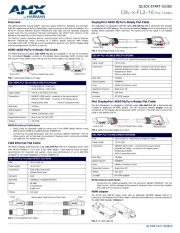
11 Juni 2025
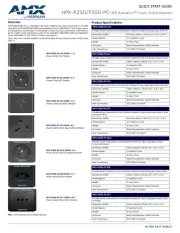
10 Juni 2025
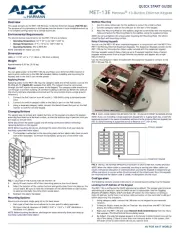
9 Juni 2025
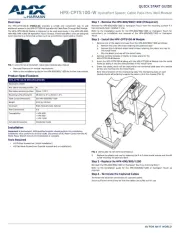
9 Juni 2025
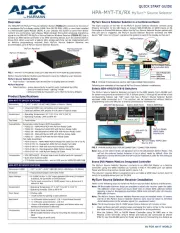
9 Juni 2025
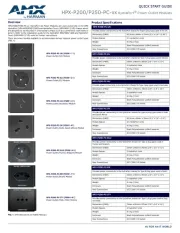
9 Juni 2025

9 Juni 2025
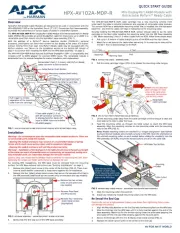
9 Juni 2025

9 Juni 2025

9 Juni 2025
Handleiding Niet gecategoriseerd
- Aim TTi
- Profoon
- Irradio BelAir
- CDN
- LISEN
- Befaco
- Waterpik
- Datacard
- Newland
- Siku
- Maestro
- Feelworld
- Aquadon
- Busch-Jaeger
- Revamp
Nieuwste handleidingen voor Niet gecategoriseerd

1 Augustus 2025

1 Augustus 2025
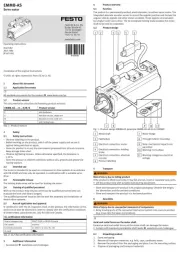
1 Augustus 2025
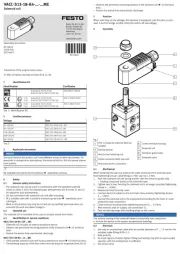
1 Augustus 2025
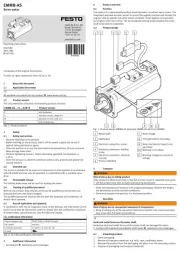
1 Augustus 2025
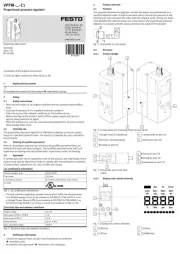
1 Augustus 2025
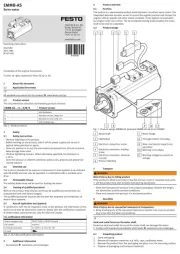
1 Augustus 2025
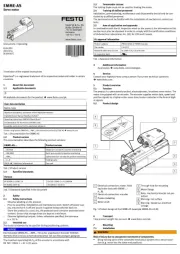
1 Augustus 2025
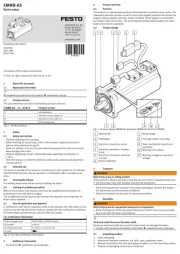
1 Augustus 2025
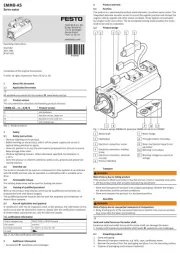
1 Augustus 2025